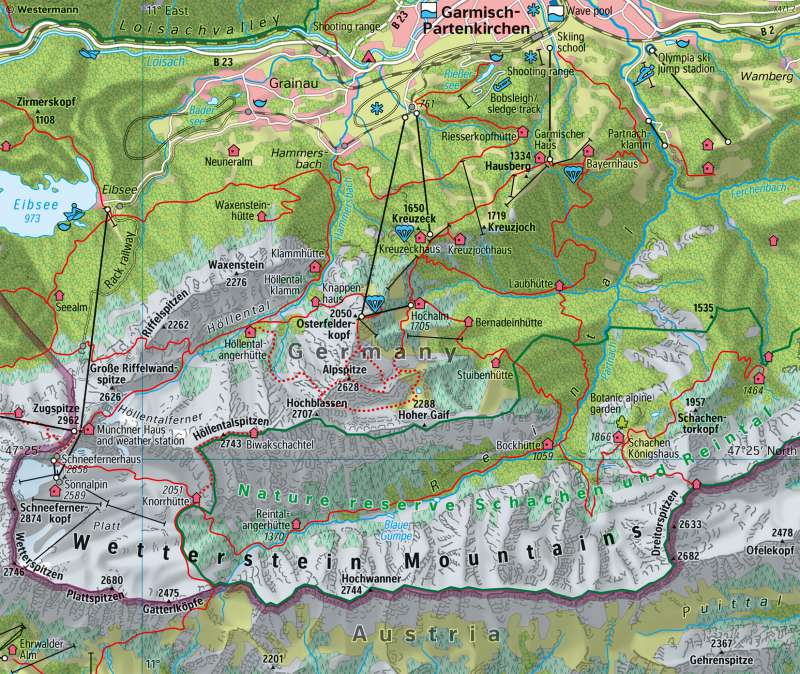Wetterstein Mountains - Tourism
Tourism and transit
978-3-14-100890-6 | Page 101 | Ill. 3

Overview
Garmisch-Partenkirchen is located in the centre of the Werdenfelser Land, a region of Upper Bavaria close to the Austrian border. To its southwest rises the 2962-metre-high Zugspitze, part of the Wetterstein Mountains. The Zugspitze is Germany's highest mountain and a major attraction for out-of-town visitors. In 2006, the Werdenfelser Land was included on the list of "National Geotopes" in Germany.
Tourism in the early days
Due to its peripheral location and lack of industry, the region was one of the poorest in Germany in the 19th century. At the time of the foundation of the German Reich in 1871, its main town, Garmisch, had a population of just over 3000 and therefore was a rather big village. An important turning point in the history of the region was the opening of a railway line from Garmisch via Murnau to Munich in 1889. With the arrival of the first summer visitors, excursionists and mountain hikers, tourism slowly set in, but initially only in summer.
A little later, skiing became popular the Alpine region, and the first ski clubs were founded around 1900. Winter sports had great economic potential because they allowed places like Garmisch to have a second season in winter. Little by little, the Werdenfelser Land developed into an increasingly popular tourist region. Tourism experienced its first peak during the Weimar Republic, when artists such as H. Mann, K. Tucholsky, E. Kästner, and L. Feuchtwanger spent their summer holidays in Garmisch or, like M. Beckmann, indulged in skiing. In 1930, the Zugspitzbahn was inaugurated, connecting Garmisch with the Schneefernerhaus.
In the Third Reich, Garmisch was a favourite destination for NSDAP officials. In 1936, the Winter Olympics were held in Garmisch-Partenkirchen, which had merged into a double resort in 1935. However, the development into mass tourism only began with the expansion of the mountain railways and ski lifts from the 1950s onwards. In 1963, the Eibsee cable car was opened southwest of Grainau. The scattered refuges for hikers or mountaineers, mostly dating from the 19th century, were partly converted into comfortable mountain inns. With hiking trails and via ferratas, places for paragliding, a multitude of ski slopes of all levels of difficulty and various offers for active holidaymakers, the region has become highly attractive for summer and winter tourists.
Tourism as the leading economic sector
The Bavarian State Ministry of Economic Affairs sees tourism as the "leading economy" in the Free State - this is especially true for Upper Bavaria and the Werdenfelser Land region. Bavaria now has more than 30 million guests and around 85 million overnight stays per year, of which more than 40 percent are in Upper Bavaria. This makes the administrative district one of the leading year-round destinations in Europe and the number one tourist region in Germany. Of Bavaria's 12.8 million inhabitants, more than 560,000 are completely dependent on tourism for their income. This industry has a dominant position especially in regions like the Werdenfelser Land, which have a picturesque landscape and a rich historical heritage in the form of monuments and sights, but hardly any other industries or economic sectors.
Over the decades, tourism has brought a high level of prosperity to the formerly poor region around Garmisch-Partenkirchen. The downsides of this development are irreversible interventions in the sensitive ecosystem of the Alps, considerable burdens from tourist and excursion traffic, especially at peak times, and a changed settlement structure, for example due to the trend towards building second homes. Moreover, there is a very one-sided orientation towards tourism. The community of Grainau with its 3,500 inhabitants, for example, has five four-star hotels and a large number of other hotels, guesthouses, inns, holiday homes, holiday flats and private rentals. This is problematic during times where travel is limited (for example due to an international crisis like the Covid pandemic).
Tourism as the leading economic sector
The Bavarian State Ministry of Economic Affairs sees tourism as the "leading economy" in the Free State - this is especially true for Upper Bavaria and the Werdenfelser Land region. Bavaria now has more than 30 million guests and around 85 million overnight stays per year, of which more than 40 percent are in Upper Bavaria. This makes the administrative district one of the leading year-round destinations in Europe and the number one tourist region in Germany. Of Bavaria's 12.8 million inhabitants, more than 560,000 are completely dependent on tourism for their income. This industry has a dominant position especially in regions like the Werdenfelser Land, which have a picturesque landscape and a rich historical heritage in the form of monuments and sights, but hardly any other industries or economic sectors.
Over the decades, tourism has brought a high level of prosperity to the formerly poor region around Garmisch-Partenkirchen. The downsides of this development are irreversible interventions in the sensitive ecosystem of the Alps, considerable burdens from tourist and excursion traffic, especially at peak times, and a changed settlement structure, for example due to the trend towards building second homes. Moreover, there is a very one-sided orientation towards tourism. The community of Grainau with its 3,500 inhabitants, for example, has five four-star hotels and a large number of other hotels, guesthouses, inns, holiday homes, holiday flats and private rentals. This is problematic during times where travel is limited (for example due to an international crisis like the Covid pandemic).




